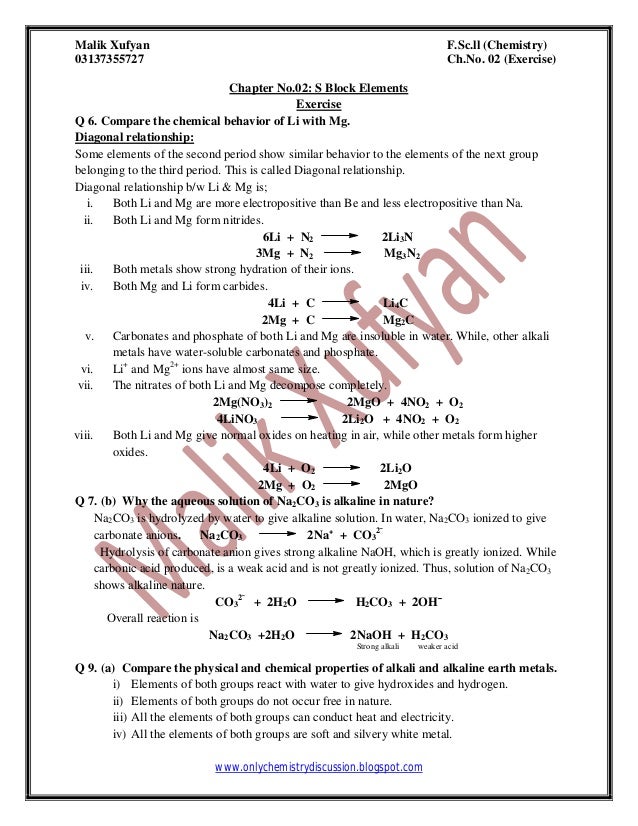
Chemistry (F.Sc.2) Chapter # 02 Exercise Solved- Malik Xufyan
- 1. Malik Xufyan F.Sc.ll (Chemistry) 03137355727 Ch.No. 02 (Exercise) www.onlychemistrydiscussion.blogspot.com Chapter No.02: S Block Elements Exercise Q 6. Compare the chemical behavior of Li with Mg. Diagonal relationship: Some elements of the second period show similar behavior to the elements of the next group belonging to the third period. This is called Diagonal relationship. Diagonal relationship b/w Li & Mg is; i. Both Li and Mg are more electropositive than Be and less electropositive than Na. ii. Both Li and Mg form nitrides. 6Li + N2 2Li3N 3Mg + N2 Mg3N2 iii. Both metals show strong hydration of their ions. iv. Both Mg and Li form carbides. 4Li + C Li4C 2Mg + C Mg2C v. Carbonates and phosphate of both Li and Mg are insoluble in water. While, other alkali metals have water-soluble carbonates and phosphate. vi. Li+ and Mg2+ ions have almost same size. vii. The nitrates of both Li and Mg decompose completely. 2Mg(NO3)2 2MgO + 4NO2 + O2 4LiNO3 2Li2O + 4NO2 + O2 viii. Both Li and Mg give normal oxides on heating in air, while other metals form higher oxides. 4Li + O2 2Li2O 2Mg + O2 2MgO Q 7. (b) Why the aqueous solution of Na2CO3 is alkaline in nature? Na2CO3 is hydrolyzed by water to give alkaline solution. In water, Na2CO3 ionized to give carbonate anions. Na2CO3 2Na⁺ + CO3 2ˉ Hydrolysis of carbonate anion gives strong alkaline NaOH, which is greatly ionized. While carbonic acid produced, is a weak acid and is not greatly ionized. Thus, solution of Na2CO3 shows alkaline nature. CO3 2ˉ + 2H2O H2CO3 + 2OHˉ Overall reaction is Na2CO3 +2H2O 2NaOH + H2CO3 Strong alkali weaker acid Q 9. (a) Compare the physical and chemical properties of alkali and alkaline earth metals. i) Elements of both groups react with water to give hydroxides and hydrogen. ii) Elements of both groups do not occur free in nature. iii) All the elements of both groups can conduct heat and electricity. iv) All the elements of both groups are soft and silvery white metal.
- 2. Malik Xufyan F.Sc.ll (Chemistry) 03137355727 Ch.No. 02 (Exercise) www.onlychemistrydiscussion.blogspot.com v) Elements of both groups are electropositive. vi) Melting points, boiling points, hardness, ionization energy decreases down the group. vii)Atomic volume, electropositivity and atomic radii increase down the group. Difference: Sr # Alkali metals Alkaline earth metals 1. They have one electron in their outermost s-orbital. They have two electrons in their outermost s-orbital. 2. They are lighter than water. They are heavier than water. 3. They have relatively low values of heat of hydration and ionization energies. They have relatively high values of hydration and ionization energies. 4. They have low melting and boiling points than alkaline earth metals. They have high melting and boiling points than alkali metals. 5. They decompose water vigorously at room temperature. 2Na + 2H2O 2NaOH + H2 They decompose water less vigorously. Mg + H2O MgO + H2 6. They are highly electropositive. They are less electropositive. 7. They do not form nitrides. They form nitrides directly on heating with N2. 3Mg + N2 Mg3N2 (b) what happens when: i. Lithium carbonate is heated. Li2CO3 LiO + CO2 ii. Lithium hydroxide is heated to red hot. 2LiOH Li2O + H2O red hot iii. Beryllium is treated with NaOH. Be + 2NaOH Na2BeO2 + H2 iv. Lithium hydride is treated with water. LiH + H2O LiOH + H2 Q 11. Answer the following questions briefly. a) Why alkali and alkaline earth metals are among the reactive elements of the periodic table? The strength of metal depends upon the ease with which it loses electron and change into positive ion. Alkali and alkaline earth metals have bigger size due to which their valance electrons are not strongly attracted. A small amount of energy is required to remove their valence electrons. Therefore, they have low ionization energy and are highly electropositive. They lose electrons easily change to positive ions and act as reducing agent. b) Why lime water turns milky with CO2 but becomes clear with excess CO2? Lime water is solution of lime CaO in water. When CaO is dissolved in water, it reacts with water to produced Ca (OH)2. When CO2 is passed through lime water it reacts with Ca (OH)2 and produced CaCO3. Ca(OH)2 + CO2 CaCO3 + H2O The milkyness disappears when excess CO2 is passed through it due to the formation of Ca(HCO3)2, which is soluble in water.
- 3. Malik Xufyan F.Sc.ll (Chemistry) 03137355727 Ch.No. 02 (Exercise) www.onlychemistrydiscussion.blogspot.com Ca(OH)2 + CO2 CaCO3 + H2O CaCO3 + CO2 + H2O Ca(HCO3)2 c) How gypsum is converted into plaster of paris? When gypsum is heated at 100˚C it loses 3/4th of its water and changes to plaster of Paris. 2CaSO4.2H2O CaSO4)2.H2O + 3H2O Or CaSO4 .H2O CaSO4.⅟2H2O + H2O d) Why 2% gypsum is added in the cement? Gypsum prevents the cement from hardening too rapidly. The addition of gypsum increases the setting time of cement increases interlocking property. e) Why lime is added to an acidic soil? Lime is added to the acidic soil. It controls the pH of soil and increase the readily soluble phosphorous. f) How lime and sand are used to make glass? Lime and sand react at high temperature to form calcium silicate (CaSiO3). Calcium silicate is further used in the formation of glass. g) How lime mortar is prepared? Ordinary mortar is also called lime mortar, is prepared by mixing freshly slaked lime with sand and water to form a thick paste. Mortar is made by mixing freshly slaked lime (one volume), sand (three or four volumes) and water to make thick paste. This material is hardened or sets when placed b/w stones and bricks. Thus, it binds the blocks firmly together. The reactions for this process are CaO + H2O Ca(OH)2 Ca(OH)2 + CO2 CaCO3 + H2O Ca(OH)2 + SiO2 CaSiO3 + H2O
